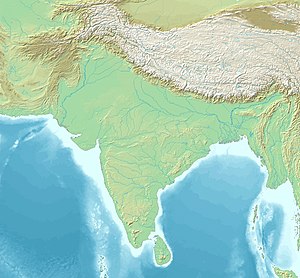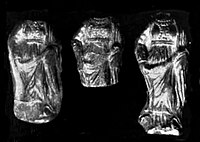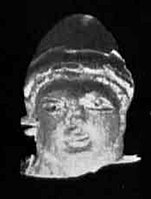Semthan
33°48′21″N 75°05′51″E / 33.805833°N 75.097500°E Semthan, also Semithan is a village 1 km north of
Excavations
The site was excavated during several seasons from 1977 to 1981.[2] Upon excavation, the site revealed several occupation layers:[1]
Period 1: pre-NBPW (700-500 BCE)
Period 2: NBPW (500-200 BCE)
Period 3:
Period 4: Kushan Empire, Huna Kingdom (1st-5th century CE)
Period 5: Hindu (5th-13th century CE)
Period 6: Late Medieval, post 13th century
Pottery wares were found in Level 3, as well as a seal with an Indo-Greek deity, and Indo-Greek coins.[1] A large number of terracotta figurines were also found in Level 4.[1][2]
Artefacts
Semthan was at one point a Greek settlement.
Such Hellenistic draped figurines have not been found at Taxila or Charsadda, although they are known to have been Indo-Greek cities, but probably this is mainly because excavations to Greek levels have been very limited: in Sirkap, only one eight of the excavations were made down to the Indo-Greek and early Saka levels, and only in an area far removed from the center of the ancient city, where few finds could be expected.[8]
-
Terracotta statuette in Chiton and Himation, Semthan
-
Male Hellenistic dress, Semthan
-
Semthan, female Hellenistic dresses
-
Figure with helmet, Semthan
-
Indo-Greek coin of Lysias and other coinage, Semthan
-
Indo-Greek coin of Lysias (130–120 BCE), Indian square standard, of the type found at Semthan
-
Semthan, sealing with Indo-Greek deity.[2]
References
- ^ ISBN 978-90-04-24832-8.
- ^ a b c d Indian Archaeology 1980-81 A Review (PDF). Archaeological Survey of India. 1981. pp. 21–23.
- JSTOR 41694416.
- ISBN 978-90-04-24832-8.
- JSTOR 41928559.
- ISBN 978-90-04-24832-8.
- ISBN 978-90-04-24832-8.
- ISBN 978-90-04-24832-8.








![Semthan, sealing with Indo-Greek deity.[2]](http://upload.wikimedia.org/wikipedia/commons/thumb/8/80/Semthan%2C_sealing_with_Indo-Greek_deity.jpg/197px-Semthan%2C_sealing_with_Indo-Greek_deity.jpg)